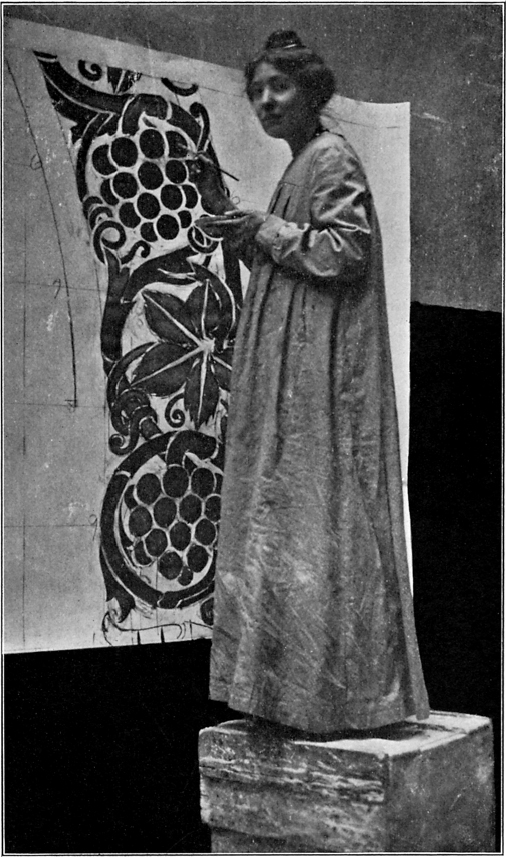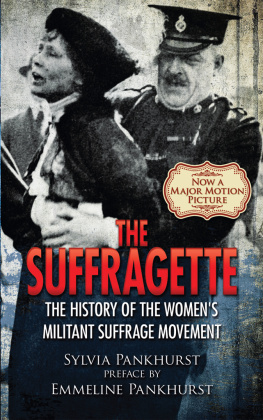
Sylvia Pankhurst designing a part of the decorations of the Princes Skating Rink
THE SUFFRAGETTE
THE HISTORY OF THE WOMENS MILITANT SUFFRAGE MOVEMENT
SYLVIA PANKHURST
P REFACE BY
EMMELINE PANKHURST
D OVER P UBLICATIONS , I NC .
M INEOLA , N EW Y ORK
Bibliographical Note
This Dover edition, first published in 2015, is an unabridged republication of the work originally published in 1911 by the Sturgis & Walton Company, New York. In the original edition, several chapters were numbered incorrectly; these errors have been retained to keep the present volume as close to the original as possible.
ILibrary of Congress Cataloging-in-Publication Data
Pankhurst, E. Sylvia (Estelle Sylvia), 1882-1960
The suffragette: the history of the womens militant suffrage movement / Sylvia Pankhurst; preface by Emmeline Pankhurst. Dover edition.
pages cm
Originally published: Sturgis & Walton Company, New York, 1911.
Includes index.
eISBN-13: 978-0-486-80731-7
1. WomenSuffrageGreat Britain. I. Title.
JN979.P3 2015
324.6230941dc23
2015014171
Manufactured in the United States by RR Donnelley
80484401 2015
www.doverpublications.com
PREFACE BY MRS. PANKHURST
T HIS history of the Womens Suffrage agitation is written at a time when the question is in the very forefront of British politics. What the immediate future holds for those women who are most actively engaged in fighting for their political freedom no one can foretell, but one thing is certain: complete victory for their cause is not far distant.
When the long struggle for the enfranchisement of women is over, those who read the history of the movement will wonder at the blindness that led the Government of the day to obstinately resist so simple and obvious a measure of justice.
The men and women of the coming time will, I am persuaded, be filled with admiration for the patient work of the early pioneers and the heroic determination and persistence in spite of coercion, repression, misrepresentation, and insult of those who fought the later militant fight.
Perhaps the women born in the happier days that are to come, while rejoicing in the inheritance that we of to-day are preparing for them, may sometimes wish that they could have lived in the heroic days of stress and struggle and have shared with us the joy of battle, the exaltation that comes of sacrifice of self for great objects and the prophetic vision that assures us of the certain triumph of this twentieth-century fight for human emancipation.
E. P ANKHURST .
4, Clements Inn, W. C, London.
J ANUARY , 1911.
PREFACE
I N writing this history of the Militant Womens Suffrage Movement I have endeavoured to give a just and accurate account of its progress and happenings, dealing fully with as many of its incidents as space will permit. I have tried to let my readers look behind the scenes in order that they may understand both the steps by which the movement has grown and the motives and ideas that have animated its promoters.
I believe that women striving for enfranchisement in other lands and reformers of future days may learn with renewed hope and confidence how the family party, who in 1905 set out determined to make votes for women the dominant issue of the politics of their time, in but six years drew to their standard the great womans army of to-day. It is certain that the militant struggle in which this womans army has engaged and which has come as the climax to the long, patient effort of the earlier pioneers, will rank amongst the great reform movements of the world. Set as it has been in modern humdrum days it can yet compare with any movement for variety and vivacity of incident. The adventurous and resourceful daring of the young Suffragettes who, by climbing up on roofs, by sliding down through skylights, by hiding under platforms, constantly succeeded in asking their endless questions, has never been excelled. What could be more piquant than the fact that two of the Cabinet Ministers who were carrying out a policy of coercion towards the women should have been forced into the witness box to be questioned and cross-questioned by Miss Christabel Pankhurst, the prisoner in the dock? What, too, could throw a keener searchlight upon the methods of our statesmen than the evidence put forward in the course of that trial?
To many of our contemporaries perhaps the most remarkable feature of the militant movement has been the flinging-aside by thousands of women of the conventional standards that hedge us so closely round in these days for a right that large numbers of men who possess it scarcely value. Of course it was more difficult for the earlier militants to break through the conventionalities than for those who followed, but, as one of those associated with the movement from its inception, I believe that the effort was greater for those who first came forward to stand by the originators than for the little group by whom the first blows were struck. I believe this because I know that the original militants were already in close association with the truth that not only were the deeds of the old time pioneers and martyrs glorious, but that their work still lacks completion, and that it behoves those of us who have grasped an idea for human betterment to endure, if need be, social ostracism, violence, and hardship of all kinds, in order to establish it. Moreover, whilst the originators of the militant tactics let fly their bolt, as it were, from the clear sky, their early associates rallied to their aid in the teeth of all the fierce and bitter opposition that had been raised.
The hearts of students of the movement in after years will be stirred by the faith and endurance shown by the women who faced violence at the hands of the police and others in Parliament Square and at the Cabinet Minister meetings, and above all by the heroism of the noble women who went through the hunger strike and the mental and physical torture of forcible feeding.
A passionate love of freedom, a strong desire to do social service and an intense sympathy for the unfortunate, together made the movement possible in its present form. Those who have worked as a part of it know that it is notable not merely for its enthusiasm and courage, but also for its cheery spirit of loyalty and comradeship, its patient thoroughness in organisation which has made possible its many great demonstrations and processions, its freedom from bitterness and recrimination, and its firm faith in the right.
E. S YLVIA P ANKHURST .
London, May, 1911.
ILLUSTRATIONS
THE SUFFRAGETTE
THE SUFFRAGETTE
CHAPTER I
EARLY DAYS
F ROM THE F ORMATION OF THE W OMENS S OCIAL AND P OLITICAL U NION TO THE S UMMER OF 1905.
F ROM her girlhood my mother, the founder of the Womens Social and Political Union, had been inspired by stories of the early reform movements, and even before this, at an age when most children have scarcely learnt their alphabet, her father, Robert Goulden, of Manchester, set her to read his newspaper to him at breakfast and thus awakened her lasting interest in politics.
The Franco-German War was still a much-discussed event when Robert Goulden took his thirteen-year-old daughter to school in Paris, placing her at the Ecole Normale, where she became the room-companion of Henri Rochforts daughter, Nomie. Nomie Rochfort told her little English schoolfellow much of her own fathers adventurous career, and Emmeline Goulden soon became an ardent and enthusiastic republican. She was now delighted to discover that she had been born on the anniversary of the destruction of the Bastille and was proud to tell her friend that her own grandmother had been an earnest politician, and one of the earliest members of the Anti-Corn Law League, and that her grandfather had narrowly escaped death upon the field of Peterloo. Even before her school days in Paris she had been taken by her mother to a Womens Suffrage meeting addressed by Miss Lydia Becker.
Next page









